AMD ascending: How Ryzen CPUs snatched the computing crown from Intel - younggich1997

Gordon Mah Ung/IDG
Monday, November 25, 2019 was a important Clarence Day. On it, AMD's benchmark-shattering, floor-wiping, mic-dropping 32-core Threadripper 3970X reviews launched alongside Intel's most potent consumer chip, the 18-burden Core i9-10980XE. The wild public presentation difference between the two respective champions drove chisel rest home a truth that's been slowly edifice and is suddenly here: First since Intel's Core architecture ended the Athlon 64's dominance nearly 15 farseeing years agone, after an AMD Bulldozer epoch seemingly eternal with disappointment, AMD's Ryzen processors are firmly in control on the desktop.
Editors bill: This article originally published on November 26, 2019, when AMD's 3rd-gen Ryzen chips claimed desktop CPU dominance. On March 30, 2020, AMD used the same underlying Zen 2 cores to seize the laptop pennant as well with Ryzen 4000 peregrine and the svelte, yet Intel-toppling 3.5 lb. Asus ROG Zephyrus G14.
"AMD's Ryzen 9 4900HS deals a crushing blow to Intel's most powerful laptop CPUs," we said in our review. "…[It] can spar with laptops that weigh two to evening three multiplication as very much. This is something we honestly didn't expect. Ryzen 4000 is without a doubt the almost lame-changing performance laptop CPU we've seen in years."
It's been coming. AMD's new-aspect Ryzen chips, built using multiple joint dies under the hood quite than a typical monolithic design, shook the up the status quo when they launched in 2017. "AMD is back!" our headline blared.
Over the previous decennium, calculation innovation had stagnated. AMD's bold Dozer gambit failed, and spell Intel's Kernel chips provided solid additive advances yr-over-year, they didn't push the multi-core performance envelope. Mainstream PCs were stuck in neutral with dual- or quad-core processors forever, and all year's four-core chip be even as more than every bit previous ones. In May 2016, with Ryzen rumors flying, Intel released the unprecedented 10-core Broadwell-E Core i7-6950X, for a precisely-as-unprecedented $1,723—a $700 premium over 8-core chips. Kinda than reward much bold money-grabbing, our Full Nerd podcast's crew declined to name a best CPU of 2016. Multiplication were bleak.
Then Ryzen happened.
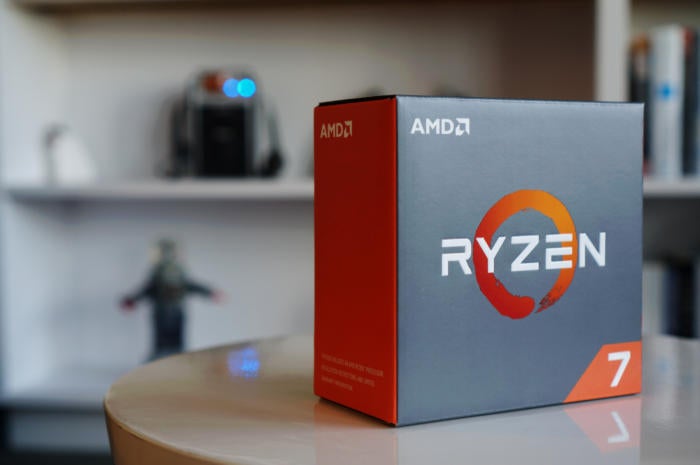 Gordon Mah Ung
Gordon Mah Ung Where Intel only offered a single $1,089 8-core chip for its high-priced broad-death background platform, AMD flooded the flying field with cores and duds. The flagship Ryzen 7 1800X cost $499, but you could pick up an 8-core Ryzen 7 1700 for just $330, and six-inwardness, 12-thread Ryzen 5 parts for atomic number 3 little as $220. Piece Intel's budget chips topped out at two cores, AMD's affordable Ryzen 3 CPUs offered four. Ryzen was a revelation, and for the first time in ages, Intel increased core counts to counter the threat.
Simply like whatsoever first-year-gen product, AMD's brand-new architecture wasn't perfect. First-gen Ryzen chips delivered outstanding multi-core performance, but their clock speeds and instructions per clock (IPC) lagged behind Intel's finely honed 14nm Core chips. Ryzen faltered in applications that demanded strong single-meander performance, most notably in 1080p play workloads that delivered far fewer frames per second happening AMD's hardware. First-gen Ryzen still did okay in those tasks, but they weren't better for everybody and AMD had a lot of room to improve.
Second-gen Ryzen processors, built on the refined Window pane+ architecture, did just that. This meter around, we said that "AMD's 2nd-gen CPUs nail the sequel." AMD improved both performance and price, with the flagship 8-core Ryzen 7 2700X topping unstylish at a mere $330, with a bundled Wraith CPU cooler. AMD boosted overall time speeds, tweaked memory cache and latent period, and introduced algorithms like Precision Encourage 2 and Extended Frequency Range (XFR) 2 to let its chips hit those high clocks much consistently.
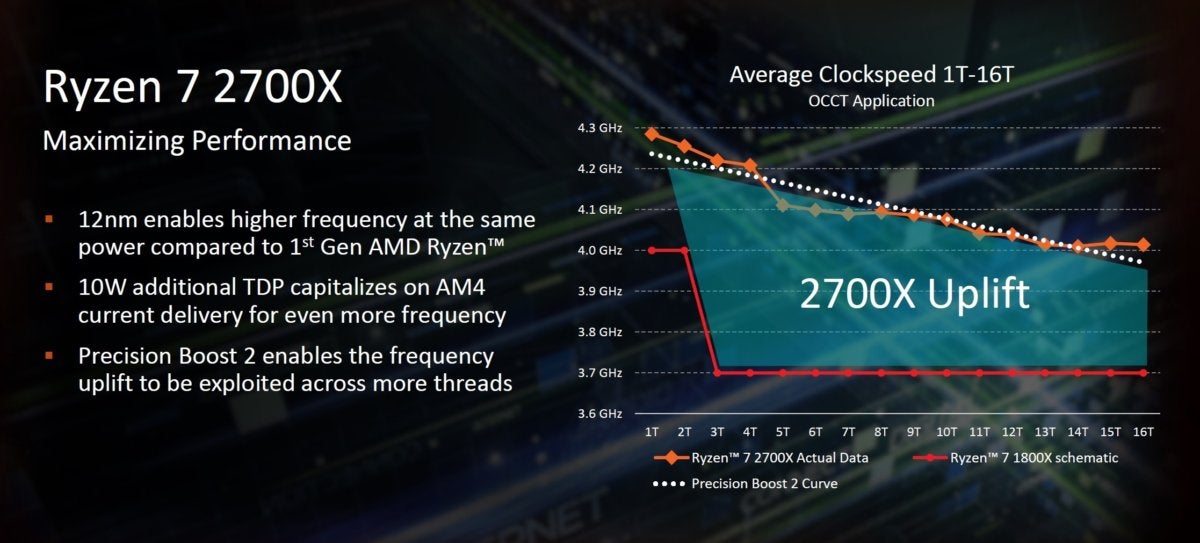 AMD
AMD More of the improvements in 2nd Ryzen comes from high clock speeds on more cores.
The end result? "In the battle of Intel and AMD's flagship processors, the clear winner now is the Ryzen 7 2700X," we wrote at the time. There were still caveats—gaming and single-thread performance still trailed Intel, though by a very much less perceptible amount—but AMD was clearly bringing the fighting to Intel.
Intel, on the other hand, started struggling right around the time of AMD's ascent. The company's vaunted manufacturing arm failed to migrate to the 10nm manufacturing process on prison term, stalling its Core processors happening more and more refined versions of 14nm cores ever since Broadwell's 2015 release. That's five full generations of 14nm revisions at this point, and rumors advise Intel's next-gen desktop chips will keep going 14nm Comet Lake cores, too.
At the same time, the much-publicized Spectre and Meltdown vulnerabilities required Intel to discharge computer software mitigations that slowed down its processors, while 9th-gen Core processors distant Hyper-Threading from the Core i5 and i7 lineups (possibly to help combat those security flaws). The companionship's factories have also struggled to meet ask for chips. Intel, "Chipzilla," plant itself uniquely weak for the first time in a long time.
Enter tierce-gen Ryzen.
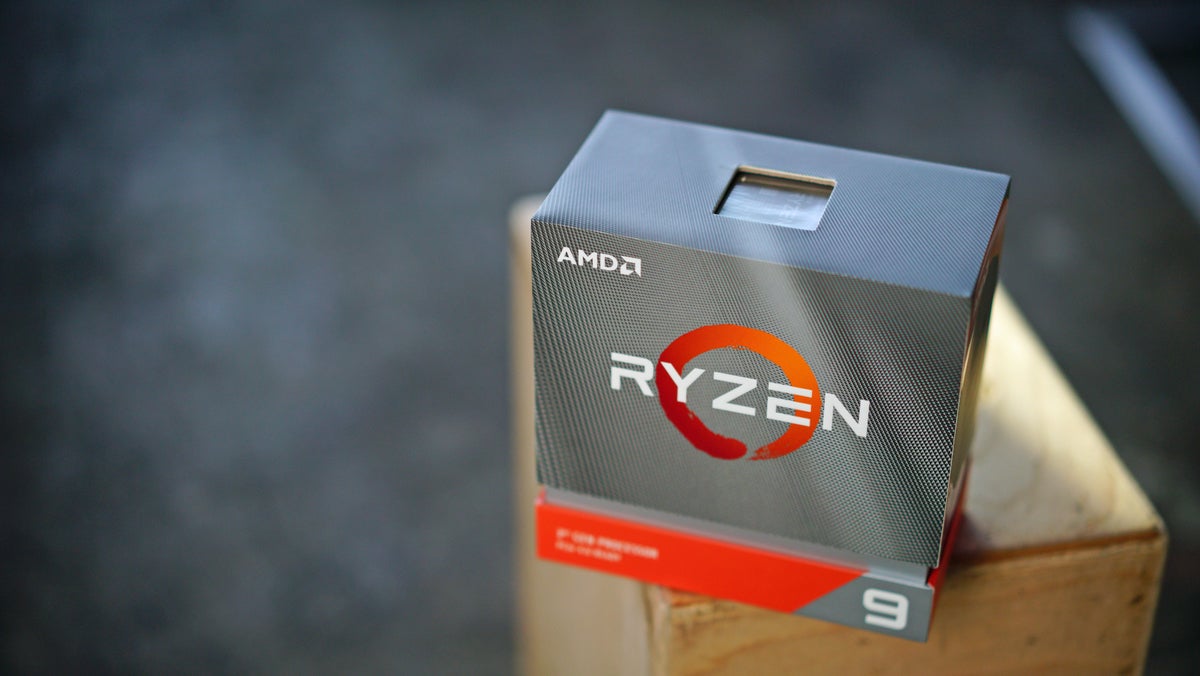 Gordon Mah Ung
Gordon Mah Ung Third-gen Ryzen introduced the Ryzen 9 series with even more cores, culminating in the 16-core Ryzen 9 3950X.
Patc Intel's stalled on 14nm, AMD's latest processors are the first ever made-up using the groundbreaking 7nm process. Better notwithstandin, third-gen Ryzen chips pushed the advantage by tapping redesigned "Zen 2" cores with doubly the floating point performance and a 15 percent IPC increase over previous Ryzen chips. Clock speeds increased, too. AMD also overhauled instruction pre-fetching, doubled the L3 cache for vastly better gaming performance, importantly rejiggered its chiplet design for lower latency, and more. These are the first processors to support the blinding-fast fresh PCIe 4.0 interface, and AMD even managed to increase core counts for its mainstream AM4 platform, hitting a monolithic 16 cores.
That's a lot of technicalese, so Here's the translation: Third-gen Ryzen chips are loaded with cores and damned fast. Previous gaming and single-thread public presentation concerns possess disappeared, and some AMD chips straight-grained pack higher IPC than competitor Intel CPUs. "On that point are very some reasons left to buy in a Core i9 now. The reasons left are real, but for credibly 9 forbidden of 10 consumers looking at a high-end CPU, they'll want to buy the Ryzen 9 3900X," we said in our review.
The persuasion holds true from top to bottom. In our guide to the best gaming CPUs, AMD chips clasp down the Budget and Top-quality Overall selections. Intel's ridonkulous Core i9-9900KS officially holds the quickest gambling crown, hit 5GHz on all cores afterward five years of 14nm refinement, just AMD's Ryzen 7 and Ryzen 9 chips nevertheless play like-minded champs and are the improve options for most people thanks to their higher core counts and lower prices.
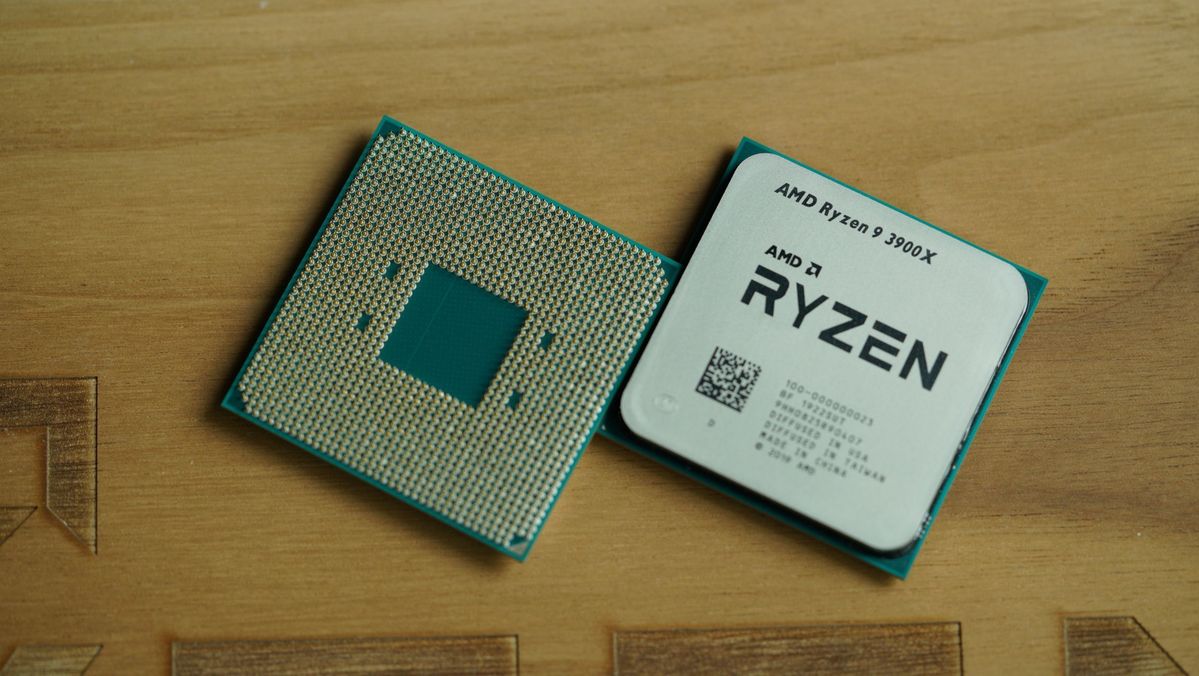 Gordon Mah Ung/IDG
Gordon Mah Ung/IDG "The Ryzen 9 3900X is likely arsenic significant, and likely as game-changing, as AMD's avant-garde K7 Athlon-series of CPUs that intersecting the 1GHz crinkle ordinal, or its Athlon 64 CPU that ushered in 64-bit computing in a desktop PC," we declared. Moving up the chain, we called the 16-core Ryzen 9 3950X "an epic final stage-zone trip the light fantastic toe over Intel"—and since then, we've seen it beat Intel's 18-core Core i9-10980XE champion in some tasks. As for the monstrous Threadripper 3970X, we said its "32 cores of unvanquishable powerfulness" merely "blow away Intel's best."
To add insult to injury, AMD even launched a 64-core Threadripper 3990X in early 2020.
Atomic number 102 weigh your budget, most people should buy up Ryzen honorable now. Careful, Intel motionless holds an reward in more or less tasks—Intel's Quick Sync tech can make a huge divergence in specific video editing workloads, Photoshop tends to prefer Intel's Core chips, and if you want to pair a high-end nontextual matter tease with a screaky-end chip to drive as many frames as possible to a 1080p gambling monitor, the Marrow i9-9900K is the way to get over. In general, Core i7 chips are quieten a large option for "unmixed gamers." Intel excels at deep encyclopaedism workloads and tasks that tap into AVX-512 book of instructions.
Simply where ahead, you needed a specific reasonableness to opt for an AMD chip over Intel, in 2019, third-gen Ryzen's dominance means you should have a specialised cause to opt for Intel over an AMD processor.
My, how the tables have turned.
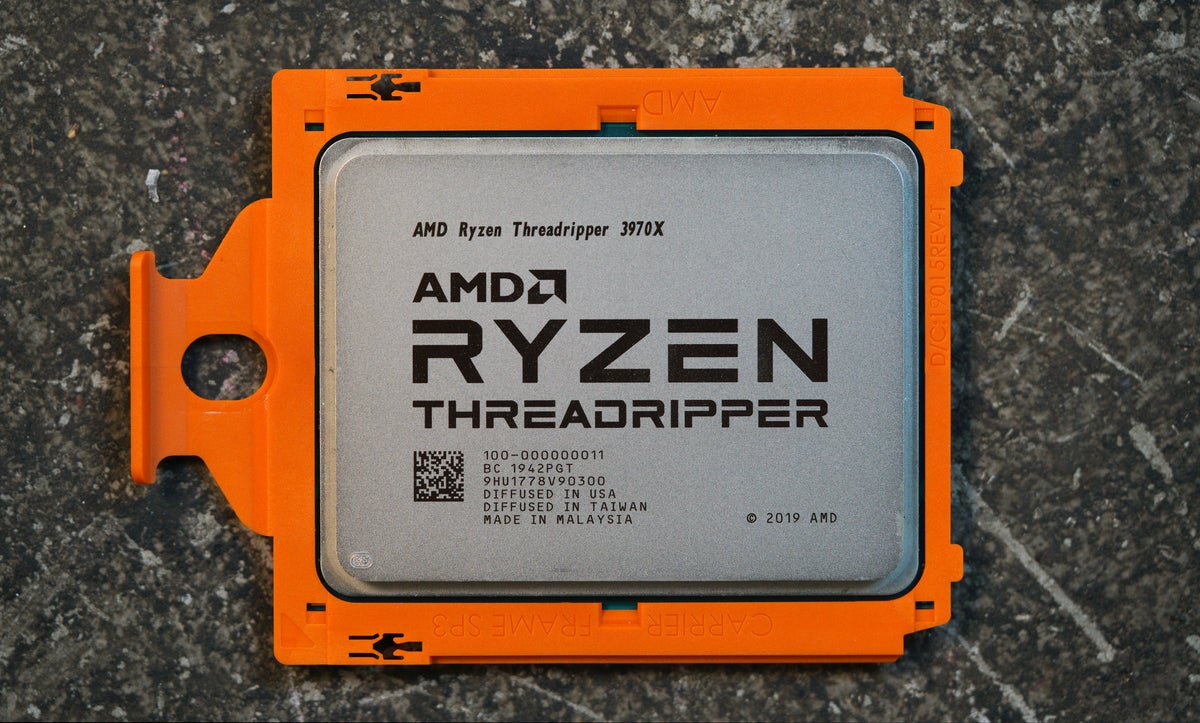 Gordon Mah Ung
Gordon Mah Ung The beastly 32-core AMD Threadripper 3970X.
Don't depend Intel outer quite yet. Information technology's still larger than AMD umteen multiplication over, and Intel Inwardness chips have maintained an iron grip on the crucial laptop market, where Ryzen chips hold struggled with power efficiency—though new Ryzen 4000 mobile CPUs improved using the same Zen 2 cores as 3rd-gen Ryzen just arrived, and whupped on every Intel gaming chip on offer in its initial Asus ROG Zephyrus G14 Incarnation. And remember: Last time Intel was on the ropes, it pulled out Conroe and the Core microarchitecture, kicking off over 15 long time of undisputed exult. There's a understanding wherefore people telephone call Intel "Chipzilla."
But for now, David's knocked off Goliath. Third-gen Ryzen processors regulation the screen background from apical to undersurface, and AMD deserves every bit of congratulations it's received for pushing computer science into the multi-core future after eld of stagnancy. "The 32-core Threadripper 3970X runs unopposed in our eyes," our evaluation concluded.
Bravo.
Billet: When you purchase something after clicking golf links in our articles, we may take in a small commission. Read our assort link policy for more details.
Brad Chacos spends his days digging through background PCs and tweeting too much.
Source: https://www.pcworld.com/article/398418/amd-ascending-how-ryzen-laptop-desktop-cpus-snatched-computing-crown-intel.html
Posted by: younggich1997.blogspot.com


0 Response to "AMD ascending: How Ryzen CPUs snatched the computing crown from Intel - younggich1997"
Post a Comment